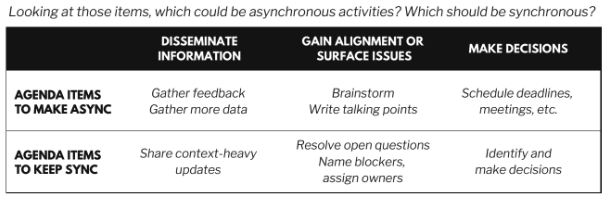Meetings are the fall guy for the failures of the office.
Whether it’s an in-person or digital meeting, we love to complain about them.
Meetings are boring. They suck the energy out of you. They overwhelm your calendar like a weed. They prevent you from getting into Focus mode. They steal your attention (your most scarce resource). And they are super expensive.
But we keep coming back for more
We’ve all chanted the “no more meetings” mantra. But we may as well chant, “no more cake for birthdays” because both are equally likely. As nice as it sounds, Calendar zero can’t be a true reality for a collaborative digital leader, right?
We can’t quit meetings. A world without meetings feels like a world without collaboration.
So, are we codependent on a toxic form of collaboration, or are we just bad at meetings? Are they a necessary evil?
Is there room for digital meetings?
As you try to create a high level digital workplace, you must question your assumptions. Is a digital meeting still worth the effort? Or should you do away with meetings once and for all and move completely to asynchronous work?
Matt Tucker, CEO of Koan says that “meetings are a microcosm of a company’s culture”. The shift to digital meetings often reveals what was already broken.
Nick Smarrelli, CEO of GadellNet says, “Bad meetings, live, can be covered up easier than bad meetings digitally. By being unprepared to lead a digital meeting, your participants will surely opt to the other distractions available to them.”
Let’s start by looking at how digital tools change meetings.
The positive changes of digital meetings
A Level 3 digital workplace sees the unique advantages that digital tools can bring to work.
- Digital meetings allow you to be location-independent.
- Digital meetings let you scale up the number of people on the call.
- Digital meetings can give instant closed captioning.
- Digital meetings let you screen share and/or work on a file collaboratively.
- Digital meetings can be recorded and quickly transcribed.
- Digital meetings can give you data on the share of speaking time to build more equity.
- You can create random breakout groups for smaller discussions.
- You can add other digital meeting technology to enrich the experience
The misuse of digital meetings
But we are also abusing digital meetings.
A recent report by Harvard Business School researchers shows that since the pandemic, the average length of meetings has dropped by 20%, the number of attendees is up by 13%, and the overall number of meetings has increased by 13%. Atlassian revealed that employees spent 400% more time on Zoom in 2020 than in 2019. Microsoft reported an increase of 148% use of Teams meetings.
Even if your meetings are shorter, if your calendar is stuffed with more of them, what’s the point?
Then there’s group chat, which feels like a day-long digital meeting stuffed into a blender and pureed into 3 minute increments. Cal Newport says we we moved backwards in our collaboration when we allowed “email meetings” to take over.
Digital meetings that aren’t engaging are more distracting for participants. And our default approach to hybrid meetings makes remote employees feel left out.
The most overlooked advantage of digital meetings
Digital meetings don’t have to be the pixelated equivalent of the most loved-to-hate part of work. So, what’s the biggest change digital tools have brought to collaboration (outside of fancy backgrounds and filters)?
In pre-digital times, if you needed to collaborate with someone, you called a meeting. Meetings were the preferred way to:
- Give group updates
- Get unstuck
- Make a decision
- Bring clarity and alignment
- Connect with team members
In fact, in this era, meetings = collaboration.
In the digital era, we have a multitude of tools at our disposal. We have email, chat, discussion boards, channels, voice memos, recorded videos, and more. In fact, most digital leaders complain about having too many options for collaboration.
And yet, our minds are still programmed to think that if you REALLY want to collaborate, you need to call a meeting.
This misses the best part about digital collaboration.
Digital collaboration is not about having eight options to do the same thing. It’s about having the ideal option for eight different scenarios.
Think of it as having an updated utility belt or toolbox.
Digital meetings are the perfect answer for one specific need. But if we keep trying to use digital meetings to do everything, we’ll keep hating them.
Why did you hire this meeting?
What are the unique strengths of digital meetings? What situations make it the perfect option to choose from your expanded utility belt?
- Make quick decisions. Formstack CEO Chris Byers says a 10 minute meeting can save days of back-and-forth messaging.
- Establish a human connection. Synchronous meetings are far superior at building camaraderie and a sense of belonging.
- Enable fast thinking. Meetings allow for rapid communication that can create unseen solutions.
- Reveal unseen problems. Meetings create serendipitous moments that uncover important issues.
- Build energy. Meetings are great at bringing some hype and forward motion.
- Realign the team. Sending a reminder email about your objectives doesn’t have the same effect as being live.
- Allow for direct inclusion. You can get pointed feedback from people who don’t like writing their thoughts, or are more quiet.
Steven Rogelberg, professor at UNC Charlotte, says, “Running meetings right can result in many positive and energizing outcomes, including better decision-making and increased innovation, cohesion, agility, and resilience — essential outcomes as teams and organizations struggle with the working challenges of the pandemic.”
What do you want this meeting to do?
The key for digital leaders is knowing when to use the digital meeting, and when to use a different option.
Lara Hogan says there are three primary purposes of meetings: disseminating information, gaining alignment, and making decisions. In this rubric, she’s outlined when it’s best to collaborate synchronously (in a meeting), or asynchronously (some other digital option).

Other good use cases for digital meetings are:
- kicking off a project
- getting unstuck from a difficult problem
- reviewing a project
- doing a live negotiation
- hanging out with folks and build better rapport
A digital meeting is a fantastic option in the right situation. But we shouldn’t hire it to do things that other collaboration forms are better at.
Digital meetings are the perfect start to upgrade your digital workplace
Meetings are sacred events. They take up a lot of time and involve human interaction. They reveal a lot about your culture and can show you what was already broken.
Making the shift to digital meetings is the perfect time to question your assumptions about meetings. You can rebuild the digital meeting for what it can be instead of what it has always been.
Start by creating some team ground rules for meetings and learning how to lead effective virtual meetings.
Share your thoughts with us about meetings on Twitter or LinkedIn!
Meetings are the fall guy for the failures of the office.
Whether it’s an in-person or digital meeting, we love to complain about them.
Meetings are boring. They suck the energy out of you. They overwhelm your calendar like a weed. They prevent you from getting into Focus mode. They steal your attention (your most scarce resource). And they are super expensive.
But we keep coming back for more
We’ve all chanted the “no more meetings” mantra. But we may as well chant, “no more cake for birthdays” because both are equally likely. As nice as it sounds, Calendar zero can’t be a true reality for a collaborative digital leader, right?
We can’t quit meetings. A world without meetings feels like a world without collaboration.
So, are we codependent on a toxic form of collaboration, or are we just bad at meetings? Are they a necessary evil?
Is there room for digital meetings?
As you try to create a high level digital workplace, you must question your assumptions. Is a digital meeting still worth the effort? Or should you do away with meetings once and for all and move completely to asynchronous work?
Matt Tucker, CEO of Koan says that “meetings are a microcosm of a company’s culture”. The shift to digital meetings often reveals what was already broken.
Nick Smarrelli, CEO of GadellNet says, “Bad meetings, live, can be covered up easier than bad meetings digitally. By being unprepared to lead a digital meeting, your participants will surely opt to the other distractions available to them.”
Let’s start by looking at how digital tools change meetings.
The positive changes of digital meetings
A Level 3 digital workplace sees the unique advantages that digital tools can bring to work.
- Digital meetings allow you to be location-independent.
- Digital meetings let you scale up the number of people on the call.
- Digital meetings can give instant closed captioning.
- Digital meetings let you screen share and/or work on a file collaboratively.
- Digital meetings can be recorded and quickly transcribed.
- Digital meetings can give you data on the share of speaking time to build more equity.
- You can create random breakout groups for smaller discussions.
- You can add other digital meeting technology to enrich the experience
The misuse of digital meetings
But we are also abusing digital meetings.
A recent report by Harvard Business School researchers shows that since the pandemic, the average length of meetings has dropped by 20%, the number of attendees is up by 13%, and the overall number of meetings has increased by 13%. Atlassian revealed that employees spent 400% more time on Zoom in 2020 than in 2019. Microsoft reported an increase of 148% use of Teams meetings.
Even if your meetings are shorter, if your calendar is stuffed with more of them, what’s the point?
Then there’s group chat, which feels like a day-long digital meeting stuffed into a blender and pureed into 3 minute increments. Cal Newport says we we moved backwards in our collaboration when we allowed “email meetings” to take over.
Digital meetings that aren’t engaging are more distracting for participants. And our default approach to hybrid meetings makes remote employees feel left out.
The most overlooked advantage of digital meetings
Digital meetings don’t have to be the pixelated equivalent of the most loved-to-hate part of work. So, what’s the biggest change digital tools have brought to collaboration (outside of fancy backgrounds and filters)?
In pre-digital times, if you needed to collaborate with someone, you called a meeting. Meetings were the preferred way to:
- Give group updates
- Get unstuck
- Make a decision
- Bring clarity and alignment
- Connect with team members
In fact, in this era, meetings = collaboration.
In the digital era, we have a multitude of tools at our disposal. We have email, chat, discussion boards, channels, voice memos, recorded videos, and more. In fact, most digital leaders complain about having too many options for collaboration.
And yet, our minds are still programmed to think that if you REALLY want to collaborate, you need to call a meeting.
This misses the best part about digital collaboration.
Digital collaboration is not about having eight options to do the same thing. It’s about having the ideal option for eight different scenarios.
Think of it as having an updated utility belt or toolbox.
Digital meetings are the perfect answer for one specific need. But if we keep trying to use digital meetings to do everything, we’ll keep hating them.
Why did you hire this meeting?
What are the unique strengths of digital meetings? What situations make it the perfect option to choose from your expanded utility belt?
- Make quick decisions. Formstack CEO Chris Byers says a 10 minute meeting can save days of back-and-forth messaging.
- Establish a human connection. Synchronous meetings are far superior at building camaraderie and a sense of belonging.
- Enable fast thinking. Meetings allow for rapid communication that can create unseen solutions.
- Reveal unseen problems. Meetings create serendipitous moments that uncover important issues.
- Build energy. Meetings are great at bringing some hype and forward motion.
- Realign the team. Sending a reminder email about your objectives doesn’t have the same effect as being live.
- Allow for direct inclusion. You can get pointed feedback from people who don’t like writing their thoughts, or are more quiet.
Steven Rogelberg, professor at UNC Charlotte, says, “Running meetings right can result in many positive and energizing outcomes, including better decision-making and increased innovation, cohesion, agility, and resilience — essential outcomes as teams and organizations struggle with the working challenges of the pandemic.”
What do you want this meeting to do?
The key for digital leaders is knowing when to use the digital meeting, and when to use a different option.
Lara Hogan says there are three primary purposes of meetings: disseminating information, gaining alignment, and making decisions. In this rubric, she’s outlined when it’s best to collaborate synchronously (in a meeting), or asynchronously (some other digital option).

Other good use cases for digital meetings are:
- kicking off a project
- getting unstuck from a difficult problem
- reviewing a project
- doing a live negotiation
- hanging out with folks and build better rapport
A digital meeting is a fantastic option in the right situation. But we shouldn’t hire it to do things that other collaboration forms are better at.
Digital meetings are the perfect start to upgrade your digital workplace
Meetings are sacred events. They take up a lot of time and involve human interaction. They reveal a lot about your culture and can show you what was already broken.
Making the shift to digital meetings is the perfect time to question your assumptions about meetings. You can rebuild the digital meeting for what it can be instead of what it has always been.
Start by creating some team ground rules for meetings and learning how to lead effective virtual meetings.
Share your thoughts with us about meetings on Twitter or LinkedIn!
)
)
)







